Ian Magnusson
DataDecide: How to Predict Best Pretraining Data with Small Experiments
Apr 15, 2025Abstract:Because large language models are expensive to pretrain on different datasets, using smaller-scale experiments to decide on data is crucial for reducing costs. Which benchmarks and methods of making decisions from observed performance at small scale most accurately predict the datasets that yield the best large models? To empower open exploration of this question, we release models, data, and evaluations in DataDecide -- the most extensive open suite of models over differences in data and scale. We conduct controlled pretraining experiments across 25 corpora with differing sources, deduplication, and filtering up to 100B tokens, model sizes up to 1B parameters, and 3 random seeds. We find that the ranking of models at a single, small size (e.g., 150M parameters) is a strong baseline for predicting best models at our larger target scale (1B) (~80% of com parisons correct). No scaling law methods among 8 baselines exceed the compute-decision frontier of single-scale predictions, but DataDecide can measure improvement in future scaling laws. We also identify that using continuous likelihood metrics as proxies in small experiments makes benchmarks including MMLU, ARC, HellaSwag, MBPP, and HumanEval >80% predictable at the target 1B scale with just 0.01% of the compute.
Scalable Data Ablation Approximations for Language Models through Modular Training and Merging
Oct 21, 2024


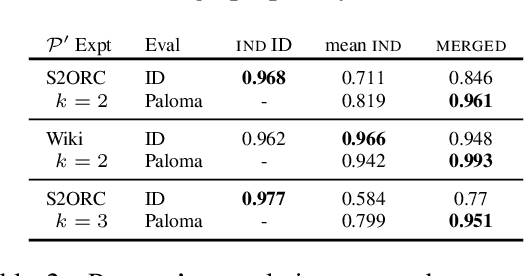
Abstract:Training data compositions for Large Language Models (LLMs) can significantly affect their downstream performance. However, a thorough data ablation study exploring large sets of candidate data mixtures is typically prohibitively expensive since the full effect is seen only after training the models; this can lead practitioners to settle for sub-optimal data mixtures. We propose an efficient method for approximating data ablations which trains individual models on subsets of a training corpus and reuses them across evaluations of combinations of subsets. In continued pre-training experiments, we find that, given an arbitrary evaluation set, the perplexity score of a single model trained on a candidate set of data is strongly correlated with perplexity scores of parameter averages of models trained on distinct partitions of that data. From this finding, we posit that researchers and practitioners can conduct inexpensive simulations of data ablations by maintaining a pool of models that were each trained on partitions of a large training corpus, and assessing candidate data mixtures by evaluating parameter averages of combinations of these models. This approach allows for substantial improvements in amortized training efficiency -- scaling only linearly with respect to new data -- by enabling reuse of previous training computation, opening new avenues for improving model performance through rigorous, incremental data assessment and mixing.
OLMo: Accelerating the Science of Language Models
Feb 07, 2024
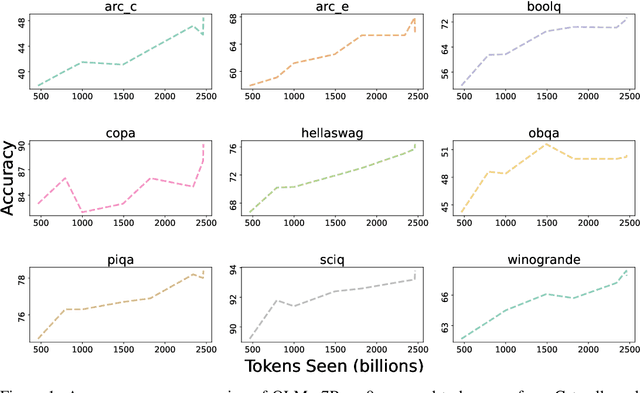
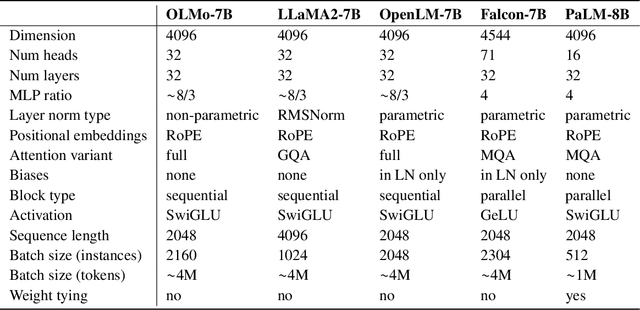
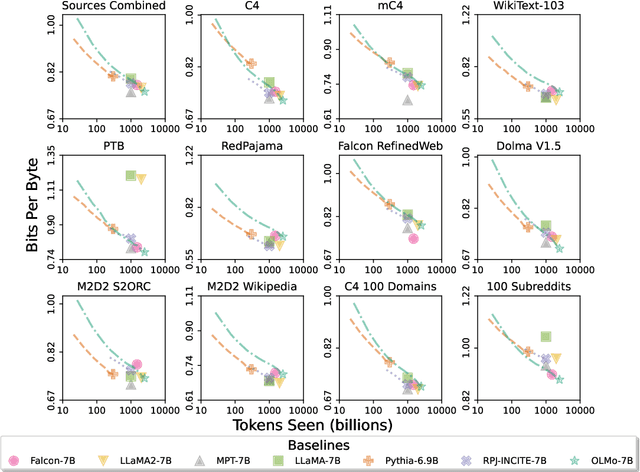
Abstract:Language models (LMs) have become ubiquitous in both NLP research and in commercial product offerings. As their commercial importance has surged, the most powerful models have become closed off, gated behind proprietary interfaces, with important details of their training data, architectures, and development undisclosed. Given the importance of these details in scientifically studying these models, including their biases and potential risks, we believe it is essential for the research community to have access to powerful, truly open LMs. To this end, this technical report details the first release of OLMo, a state-of-the-art, truly Open Language Model and its framework to build and study the science of language modeling. Unlike most prior efforts that have only released model weights and inference code, we release OLMo and the whole framework, including training data and training and evaluation code. We hope this release will empower and strengthen the open research community and inspire a new wave of innovation.
Dolma: an Open Corpus of Three Trillion Tokens for Language Model Pretraining Research
Jan 31, 2024



Abstract:Language models have become a critical technology to tackling a wide range of natural language processing tasks, yet many details about how the best-performing language models were developed are not reported. In particular, information about their pretraining corpora is seldom discussed: commercial language models rarely provide any information about their data; even open models rarely release datasets they are trained on, or an exact recipe to reproduce them. As a result, it is challenging to conduct certain threads of language modeling research, such as understanding how training data impacts model capabilities and shapes their limitations. To facilitate open research on language model pretraining, we release Dolma, a three trillion tokens English corpus, built from a diverse mixture of web content, scientific papers, code, public-domain books, social media, and encyclopedic materials. In addition, we open source our data curation toolkit to enable further experimentation and reproduction of our work. In this report, we document Dolma, including its design principles, details about its construction, and a summary of its contents. We interleave this report with analyses and experimental results from training language models on intermediate states of Dolma to share what we have learned about important data curation practices, including the role of content or quality filters, deduplication, and multi-source mixing. Dolma has been used to train OLMo, a state-of-the-art, open language model and framework designed to build and study the science of language modeling.
Paloma: A Benchmark for Evaluating Language Model Fit
Dec 16, 2023Abstract:Language models (LMs) commonly report perplexity on monolithic data held out from training. Implicitly or explicitly, this data is composed of domains$\unicode{x2013}$varying distributions of language. Rather than assuming perplexity on one distribution extrapolates to others, Perplexity Analysis for Language Model Assessment (Paloma), measures LM fit to 585 text domains, ranging from nytimes.com to r/depression on Reddit. We invite submissions to our benchmark and organize results by comparability based on compliance with guidelines such as removal of benchmark contamination from pretraining. Submissions can also record parameter and training token count to make comparisons of Pareto efficiency for performance as a function of these measures of cost. We populate our benchmark with results from 6 baselines pretrained on popular corpora. In case studies, we demonstrate analyses that are possible with Paloma, such as finding that pretraining without data beyond Common Crawl leads to inconsistent fit to many domains.
Catwalk: A Unified Language Model Evaluation Framework for Many Datasets
Dec 15, 2023Abstract:The success of large language models has shifted the evaluation paradigms in natural language processing (NLP). The community's interest has drifted towards comparing NLP models across many tasks, domains, and datasets, often at an extreme scale. This imposes new engineering challenges: efforts in constructing datasets and models have been fragmented, and their formats and interfaces are incompatible. As a result, it often takes extensive (re)implementation efforts to make fair and controlled comparisons at scale. Catwalk aims to address these issues. Catwalk provides a unified interface to a broad range of existing NLP datasets and models, ranging from both canonical supervised training and fine-tuning, to more modern paradigms like in-context learning. Its carefully-designed abstractions allow for easy extensions to many others. Catwalk substantially lowers the barriers to conducting controlled experiments at scale. For example, we finetuned and evaluated over 64 models on over 86 datasets with a single command, without writing any code. Maintained by the AllenNLP team at the Allen Institute for Artificial Intelligence (AI2), Catwalk is an ongoing open-source effort: https://github.com/allenai/catwalk.
What's In My Big Data?
Oct 31, 2023
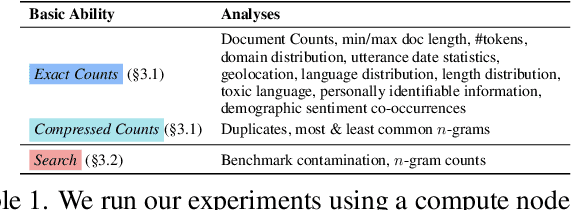


Abstract:Large text corpora are the backbone of language models. However, we have a limited understanding of the content of these corpora, including general statistics, quality, social factors, and inclusion of evaluation data (contamination). In this work, we propose What's In My Big Data? (WIMBD), a platform and a set of sixteen analyses that allow us to reveal and compare the contents of large text corpora. WIMBD builds on two basic capabilities -- count and search -- at scale, which allows us to analyze more than 35 terabytes on a standard compute node. We apply WIMBD to ten different corpora used to train popular language models, including C4, The Pile, and RedPajama. Our analysis uncovers several surprising and previously undocumented findings about these corpora, including the high prevalence of duplicate, synthetic, and low-quality content, personally identifiable information, toxic language, and benchmark contamination. For instance, we find that about 50% of the documents in RedPajama and LAION-2B-en are duplicates. In addition, several datasets used for benchmarking models trained on such corpora are contaminated with respect to important benchmarks, including the Winograd Schema Challenge and parts of GLUE and SuperGLUE. We open-source WIMBD's code and artifacts to provide a standard set of evaluations for new text-based corpora and to encourage more analyses and transparency around them: github.com/allenai/wimbd.
Reproducibility in NLP: What Have We Learned from the Checklist?
Jun 16, 2023



Abstract:Scientific progress in NLP rests on the reproducibility of researchers' claims. The *CL conferences created the NLP Reproducibility Checklist in 2020 to be completed by authors at submission to remind them of key information to include. We provide the first analysis of the Checklist by examining 10,405 anonymous responses to it. First, we find evidence of an increase in reporting of information on efficiency, validation performance, summary statistics, and hyperparameters after the Checklist's introduction. Further, we show acceptance rate grows for submissions with more Yes responses. We find that the 44% of submissions that gather new data are 5% less likely to be accepted than those that did not; the average reviewer-rated reproducibility of these submissions is also 2% lower relative to the rest. We find that only 46% of submissions claim to open-source their code, though submissions that do have 8% higher reproducibility score relative to those that do not, the most for any item. We discuss what can be inferred about the state of reproducibility in NLP, and provide a set of recommendations for future conferences, including: a) allowing submitting code and appendices one week after the deadline, and b) measuring dataset reproducibility by a checklist of data collection practices.
Just-DREAM-about-it: Figurative Language Understanding with DREAM-FLUTE
Oct 28, 2022Abstract:Figurative language (e.g., "he flew like the wind") is challenging to understand, as it is hard to tell what implicit information is being conveyed from the surface form alone. We hypothesize that to perform this task well, the reader needs to mentally elaborate the scene being described to identify a sensible meaning of the language. We present DREAM-FLUTE, a figurative language understanding system that does this, first forming a "mental model" of situations described in a premise and hypothesis before making an entailment/contradiction decision and generating an explanation. DREAM-FLUTE uses an existing scene elaboration model, DREAM, for constructing its "mental model." In the FigLang2022 Shared Task evaluation, DREAM-FLUTE achieved (joint) first place (Acc@60=63.3%), and can perform even better with ensemble techniques, demonstrating the effectiveness of this approach. More generally, this work suggests that adding a reflective component to pretrained language models can improve their performance beyond standard fine-tuning (3.3% improvement in Acc@60).
Exploring The Landscape of Distributional Robustness for Question Answering Models
Oct 22, 2022Abstract:We conduct a large empirical evaluation to investigate the landscape of distributional robustness in question answering. Our investigation spans over 350 models and 16 question answering datasets, including a diverse set of architectures, model sizes, and adaptation methods (e.g., fine-tuning, adapter tuning, in-context learning, etc.). We find that, in many cases, model variations do not affect robustness and in-distribution performance alone determines out-of-distribution performance. Moreover, our findings indicate that i) zero-shot and in-context learning methods are more robust to distribution shifts than fully fine-tuned models; ii) few-shot prompt fine-tuned models exhibit better robustness than few-shot fine-tuned span prediction models; iii) parameter-efficient and robustness enhancing training methods provide no significant robustness improvements. In addition, we publicly release all evaluations to encourage researchers to further analyze robustness trends for question answering models.
 Add to Chrome
Add to Chrome Add to Firefox
Add to Firefox Add to Edge
Add to Edge